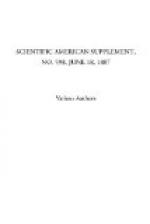In conclusion, the lecturer showed a piece of glass, the surface of which had been decomposed, a ray of light transmitted through which showed upon the screen patches of very pure color. These he considered to be due to the glass consisting of a number of thin plates, some of which had been removed by the decomposition.
* * * * *
BELT JOINTS.
From time to time, serious accidents have taken place, and the progress of work stopped, by the sudden snapping of driving belts in machinery, and, as a general rule, it is found that the collapse is attributable either to faulty leather or insecure joining. A great improvement of the leather intended for belts has been brought about during the last few years, by the introduction of improved processes for currying and the subsequent treatment. Paterson has worked successfully a patent for rendering belt leather more pliable, and lessening the tendency to stretch. Under this treatment the leather is either curried or rough dried, and then soaked in a solution of wood, resin, and gum thus, or frankincense, first melted together, and then dissolved, by the application of heat, in boiled or linseed oil. The leather, after this process, is soaked in petroleum or carbon bisulphide containing a little India-rubber solution, and is finally washed with petroleum benzoline. Should the mixture be found to be too thick, it is thinned down with benzoline spirit until it is about the consistency of molasses at the ordinary temperature. The leather so prepared is not liable to stretch, and can be joined in the usual way by copper riveting, or the ends can be sewn. A good material for smaller belts, and for strings and bands for connecting larger ones, is that recently patented by Vornberger, in which the gut of cattle is the basis. After careful




